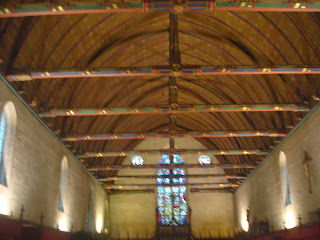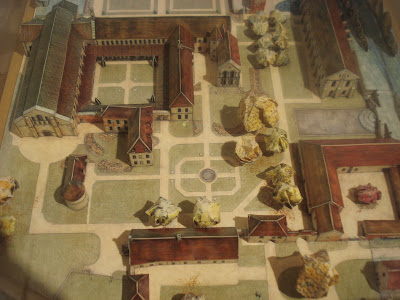Hi guys! So I spent this past weekend with our group in Burgundy, but I just realized I had some old pictures on my camera that I hadn't put up yet so I'll explain those first! They're from Montmartre, which is the area in the north of Paris that used to be a completely separate village and was notable for its gypsum mines. However, the mines closed down when the gypsum started to run out/people started to realize that if you keep mining underneath a hill it will eventually collapse. The area really got incorporated into the city in the late 19th/early 20th century, and became a mecca for artists, musicians, and bohemians. The area is home to the famous Moulin Rouge, the Sacred Heart church, and its amazing view overlooking Paris.
This cute little pink building is a famous cabaret - Au Lapin Agile, or the Agile Rabbit. It got its name because of the painting that you can almost see right above the gray-haired woman's head. The painting was completed in the late 1800's by Andre Gill, so people began calling it "Le Lapin à Gill," or "Gill's rabbit," which eventually got bastardized to "Au Lapin Agile."
A Montmartre street, with a slight view of the corner of the famous vineyard on the right.
This tiny little field represents Paris' only surviving vineyard. The grapes are still harvested to make wine every year, and apparently it's a big event.
Pictures of other pretty streets and gardens...
Most of the apartment buildings in Paris look something like this. I realized I've gotten so used to it that I barely even notice anymore, but they're so pretty!!!
This little greenhouse-like building apparently holds several artists' studios, most of which were home to famous artists at some point.
This is the main entrance to the Hospice de Beaune, a hospital for the poor that was founded in 1443 and is now a museum.
A close-up of the courtyard.
More of the courtyard. So cool!
This room had 30 of these tiny beds all packed in together.
The coolest part about this room though was the ceiling! The rafters were all brightly colored, and its shape is supposed to look like an inverted ship (either that or the people who built it actually WERE shipbuilders and that was the only design they knew. Our tourguide was speaking quietly and my French isn't perfect, you know).
For some reason there was also an alter in this room, not sure if they also prayed there or what. The tourguide didn't have anything to say on that subject at all.
But there was a fancy stained glass window!
At the end of each rafter there was also an animal decoration. It was pretty dark, so this was the only one I could get... I'm pretty sure it's supposed to be a dragon, but there were also all sorts of exotic real animals too.
The kitchen!
Examples of medieval art in the hospice's museum.
The museum also had a random collection of wine-related things, since the town of Beaune is the wine capital of the area and there's a huge wine market. These are fancy little wine tasters - you use them to taste a small sample of wine and see if it's good. Pretty sure they're from the 19th century.
Outside the museum there was an adorable outdoor market going on! I bought some cool gifts, and we all noticed how much nicer the people were here than in Paris.
A random street, no idea why I took this picture actually.
Afterwards we went to a vineyard for a wine tasting! The word for "tasting" in French is "dégustation" (which is apparently also a word in English, but the French use it WAY too much) and we always laugh about how that's such a disgusting word for something so delicious.
The guy who worked at this wine place (in french they call it a "cave" as a general term, i think that's hilarious) explained to us how they turn the grapes into wine. He used way too many specific, technical terms, so I can't actually tell you what these are besides that they store something. But they remind me of the cider machines they have at apple orchards!
I actually do know what this one is. I think it's safe to call it a "squisher" because you put white grapes in it to squeeze out all the juices! Fun fact: the method to make white and red wine are actually completely different processes, I always thought white wine was just white grapes and red wine was red grapes. Also, apparently every red wine made in Burgundy is a pinot noir and every white wine is a Chardonnay, in general. That means nothing to me, but the French are very particular about it. They also have specific types that are named after the exact plot of land it comes from (think: one plot of a few acres of land produces a wine so specific it has its own name).
According to my friend, this type of facade is on almost every French gothic church, and she's an art history major so I assume that she knows things. It's a bit hard to tell from the figure, but that's Jesus hanging out in the middle with heaven on his right side and hell on his left side. This church is in the town of Autun, where we spent Saturday night.
Examples of more engravings inside the church.
Exterior of the church. I just struggled to spell the word exterior in english because in French it has 4 extra vowels just for fun, my brain is really struggling with the language thing. Anyway, Europeans are super proud of all their churches but to be honest they all look the same. Every gothic church in France looks like this. Still cool, but not too original!
Autun also had a museum, mostly full of more medieval artwork.
Seeing this huge American truck squeeze through the tiny medieval streets of this town might have been the funniest/scariest thing I've seen in a while. I just had to take a picture of its size in juxtaposition with traditional buildings that are hundreds of years old.
Next we went to the Abbey of Fontenay, which was founded in 1118 and is a complete joke because monks lived there, not nuns. Not sure why they didn't call it a monastery, but it looked like a beautiful but harsh place to live.
This is the room where all the monks would sleep, without heating, and with only a thin blanket to keep them warm. Notice how this hall has the same inverted boat ceiling as at the hospice de beaune, but it's much more sober.
Most of the buildings in the abbey actually date from the 12th or 13th centuries, but this is a young one - it was built sometime in the 18th or 19th.
Despite their simple lifestyle, the monks at the abbey were actually quite well off because they had their own forge.
They also had a water wheel!
Model showing the full water wheel. It was huge!
The abbey was called "fontenay" because of all its fountains. It was quite cold when we were there, but the fountains were still on.
Model of the entire site.
This looks like the exact same picture again, right? This church is actually in a different town, Vézelay, which was apparently quite a big deal. Two crusades were started/announced here, and it's still an important stop on the European pilgrimage trail.
More of the church's facade.
This church also had a second facade on the inside, and guess what it was decorated with?
The ceiling of the inside of the church was really cool. The stripes on the stone "rafters" were created by using strips of white and dark stone.
This is a side shot of the alter, which is surrounded by pillars and is open rather than being surrounded by walls.
Another shot of the interior.
Finally, a real medieval church can't be a big deal without having some sort of saint's relics. Inside this little magic box thing is supposedly some of Mary Magdalene's bones, so that's cool! We had to climb down into the crypt to see them, and apparently we accidentally interrupted a baptism. We snuck out as soon as we realized, but I don't think they were upset. How were we supposed to know that French people baptize their kids in crypts?
And those are all the pics I have! Hopefully I'll have more soon, everything is getting very Christmas-y so there's a lot to see in Paris!




















































